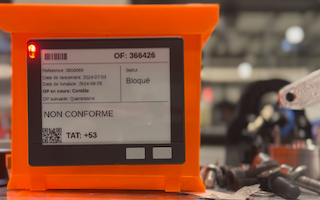Ubudu's UWB RTLS: A game-changer in indoor positioning and tracking

Key features of Ubudu's UWB RTLS technology
One of the key differentiators of Ubudu's UWB RTLS is its implementation of TDoA (time difference of arrival) positioning technique. This algorithm enables the most battery-efficient mode on tag, making it possible for businesses to operate for longer periods without needing to replace the batteries on the tags. This is because the TDoA algorithm only requires tags to periodically send short, low-power signals to the anchors, minimising the amount of energy required to keep the tags active. What is demanding in TDoA algorithm is that there is a requirement of keeping the clocks of all anchors devices accurately synchronised all the time. An important feature of Ubudu's UWB RTLS is that this clock synchronisation is an automatic process and most importantly it is 100% wireless making the system really easy to deploy, without any extra wires and calibration.
The map matching and NLOS handling algorithms in Ubudu's UWB RTLS are also noteworthy. These algorithms enable the system to accurately track objects even when they are located in areas with obstructed or limited line-of-sight (NLOS). The system always uses a combination of RF signal measurements, data from inertial measurement units (IMUs) and also previously computed positions in to always determine the most accurate position of assets.

Horizontal distributed computing scaling is another key feature of Ubudu's UWB RTLS. This allows the system to scale to thousands of anchors and tags, making it suitable for large-scale deployments in complex environments. The system is also highly responsive, with computation times of less than 2-3 milliseconds, even when tags are blinking at intervals of several minutes or hours.

Finally, Ubudu UWB RTLS can cooperate with advanced accelerometer and IMU chips mounted on the tags. This makes it possible to track not just the location of objects, but also their orientation and movement. This is especially useful in applications such as asset tracking, where it is important to know not just the location of an object, but also its condition and how it is being handled.
Full visibility of the Ubudu RTLS through graphs that monitor all system components’ health and status
In addition to its powerful indoor positioning and tracking capabilities, Ubudu's UWB RTLS also includes a series of dashboards that enable users to monitor and manage the system. These dashboards provide valuable insights into the performance of the system, including the quality of the anchor topology, clock synchronisation, and location engine throughput. The dashboards enable users to supervise the infrastructure, monitor the performance of the system in real-time and have alerts triggered in case of problems being detected. This makes it possible to quickly identify and address any issues that may arise, ensuring that the system continues to function smoothly and reliably.
Overall, the dashboards provide an additional layer of control and oversight to Ubudu's UWB RTLS, making it easier for users to manage and optimise the system for their specific needs. Whether it's monitoring the performance of the system or making adjustments to the anchor topology, the dashboards provide users with the tools they need to ensure that the system is operating at its best.

Ubudu's UWB RTLS has a wide range of applications across various industries. Let's take a closer look at some specific applications where this technology can be particularly beneficial.
In the manufacturing industry, Ubudu's UWB RTLS can be used to track the location of tools, equipment, and materials in real-time. This makes it possible to optimise workflows, reduce downtime, and increase productivity. For example, if a tool or piece of equipment is misplaced, the system can quickly locate it, minimising delays and preventing work stoppages. The military defence industry can also benefit from Ubudu's UWB RTLS for training purposes. The system can be used to track the location and movements of soldiers in training simulations, providing valuable data for analysis and improving training outcomes.
In the restaurant industry, Ubudu's UWB RTLS can be used for table service. The system can track the location of servers and customers in real-time, making it possible to provide faster and more efficient service.
Other applications for Ubudu's UWB RTLS include warehouse management, asset tracking, and healthcare. In warehouses, the system can be used to track inventory and optimise supply chain management. In asset tracking, it can be used to track the location and condition of high-value assets, such as medical equipment. In healthcare, the system can be used to track the location of patients and medical personnel, improving response times and patient outcomes.
Overall, Ubudu's UWB RTLS is a versatile technology that has numerous applications across various industries. Its high accuracy, reliability, and scalability make it a valuable tool for businesses and organisations looking to optimise workflows, improve efficiency, and increase productivity.
In conclusion, Ubudu's UWB RTLS is a powerful technology that offers a range of benefits to businesses in a variety of industries. Its TDOA algorithm, automatic clock synchronisation, map matching and NLOS handling algorithms, horizontal distributed computing scaling, and support for accelerometer and IMUs make it a highly accurate, reliable, and scalable solution for indoor positioning and tracking.
News that might interest you

BLE ESL and RTLS Integration in Manufacturing
Ubudu’s BLE ESL integration with its RTLS delivers real-time asset tracking and automated updates for manufacturing. Featuring dynamic ESL displays from brands like PDI Digital and Minew—with options in size, interchangeable batteries, and shock protection—this solution streamlines workflows using a wireless BLE network, available via SaaS or on-premise.

The power of Hybrid RTLS solutions
Hybrid RTLS combines the benefits of different location tracking technologies to provide the most efficient results for tracking needs and can be used for multiple use cases. As indoor and outdoor positioning become increasingly interconnected, it is important to consider how to combine different RTLS technologies to improve ROI and meet the needs of end-users.

Introduction to Ubudu BLE Controller
Ubudu launches “BLE Controller”, a new feature available in Ubudu RTLS that will enable you to communicate with any RTLS tag remotely, right from your desk.




